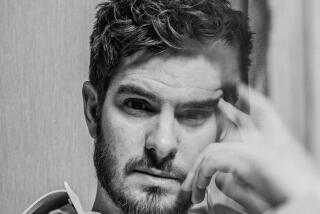Dreams and Scenes From Working-Class Hollywood : A Film-Making Family Fights Uphill Struggle
This is the story of a hard-working family on a limited budget pursuing the Hollywood dream.
Mom is actress Sharon Farrell, star of “The Reivers” and in 1970 described as one of the decade’s most promising young film talents. Her career never quite gained its full potential, though she worked steadily for a good number of years. She’s still got her looks and her sweet, ingenuous Southern personality, but at age 40 finds acting jobs tough to come by.
Dad is Dale Trevillion, an engineer whiz in system and cost analysis for the Army before he dropped out to become a film maker. Except for an occasional gig consulting on the so-called “Star Wars” (Strategic Defense Initiative), the 43-year-old Mississippi native, who wears his sandy blond hair in a shoulder-length mane and favors tie-died T-shirts and mirrored sunglasses, considers himself a Hollywood hyphenate--a writer-director-producer of feature films.
Son is Chance Boyer, 18, blond, blue-eyed, tan and handsome, teen heart-throb material if he can get the right acting breaks.
Together they’ve made a little film. Not the artsy labor of love or personal statement you might expect from the Cassavettes crowd or Henry Jaglom’s extended clan. Nor is it a major studio release built on star power and connections akin to the families Fonda or Douglas.
Nope. Father knows how to analyze his systems. This project is far more pragmatic. It’s an action-adventure flick called “One Man Force,” a “designer film,” Trevillion says without apology. Written, directed and produced by Trevillion and budgeted at $1.3 million, “Force” features the late John Matuszak as a narcotics detective.
Highlights include the ex-football star Matuszak crushing a thug with a refrigerator, battling bad guys in a high-speed mountain road chase, and shooting a lawyer’s ear off. (“I had a few guys in mind when I wrote that,” Trevillion says with a chuckle.) Farrell plays the widow of Matuszak’s partner; Boyer plays her troubled son.
The idea was that “One Man Force” would help Farrell get work again on TV, boost Boyer’s career chances and pave the way for Trevillion’s move to bigger-budget films. Not great expectations, but reasonable ones. Now they’re not sure what it will do.
The film’s theatrical release had been scrubbed by the time of Matuszak’s death June 17. Distributor Shapiro Glickenhaus had earlier dropped the original release plans for a number of cities, including Los Angeles, due to summer blockbusters crowding the theaters. They decided instead to test it on 17 screens in Atlanta. With bookings in some of that city’s better theaters and a “substantial” advertising campaign, but, Trevillion says, virtually no publicity, it premiered June 2.
The Atlanta Constitution called it an “episode of Miami Vice caught in the spin-dry cycle.” Action-adventure fans went to see Hulk Hogan’s “No Holds Barred” and “One Man Force” did $12,000 in its first weekend. It closed June 8.
“Definitely disappointing,” Robert Berney, national sales director for Shapiro Glickenhaus, says of the results. It will now go directly to video, hitting the stores by September.
Trevillion knows all too well that failures happen in Hollywood. Not one to dwell on the negative, he’ll move ahead with efforts to get financing for his next project, a $4-million “youth-oriented action adventure picture.” Boyer will be in it, but not the lead. Trevillion dreams of bagging Keifer Sutherland or Emilio Estevez.
“I need a name to put it together,” Trevillion says, sitting with Boyer and Farrell in the sunroom of their Beverly Hills apartment. (Farrell and Trevillion have since moved to a small cabin in Topanga. Boyer has taken an apartment with Josh Evans, son of Ali McGraw and Robert Evans.) “Hopefully, Chance, after a couple more films will be a marquee name.” The same problem holds for Farrell. “Right now I can’t star Sharon in a film because she doesn’t have enough star power,” Trevillion says. When he gets a big-enough name, he’ll give her a role worthy of her talents. “She’s definitely one of the great untapped resources,” he says. “But try telling that to the people you’re trying to raise money from.”
Such are the cruel realities of kinship in Hollywood.
Farrell was still a name that could attract film financing when she and Trevillion met in 1975 on the set of “The Premonition.” Trevillion describes it as a science-fiction “tax-shelter picture put together for Avco-Embassy.” He was associate producer and script doctor and Farrell was the star. Trevillion had seen her photo in the piles of 8x10s in the producers’ offices, remembered her from “The Reivers” and urged them to cast her.
Farrell was attracted to his efficiency. “He was the only person I’d ever seen on a set that got anything done,” she says. “If a car didn’t work, he’d get the car started. I was just really impressed with him. And I wanted to be part of making films. I didn’t want to be just an actress.”
Trevillion had been a rising young star in military research and development before he sought to be a film maker. The Mississippi native had been one of 20 graduate students chosen in 1966 for an Army systems research program sponsored by then-Secretary of Defense Robert S. McNamara. As one of McNamara’s Whiz Kids, he headed a civilian research and development group working on weapons for Vietnam. The field lost its appeal when, toward the end of the war, he often faced protesters on his way to work.
He longed for a more creative outlet. “I liked film because it was dealing with people’s emotions,” he says, “working with their deep fears, their loves and desires, getting close to the human heart. That’s how I prefer to make change in the world.”
He enrolled in film school at NYU. Classmates included Robert Colesberry, co-producer of “Mississippi Burning.” They studied all the great European film makers, Trevillion recalls. Bunuel was his favorite. He dropped out after his first summer job working with Colesberry on an independent feature, “The Haunt.” “The Premonition” was his second film assignment.
“The Premonition” was a curve on the comeback trail for Farrell, trying to regain the momentum she’d lost after the first push from “The Reivers.” She had been pregnant during that film. Medical complications from Boyer’s birth kept her from film work for several years. Sharon jumps up to look for the 1970 list forecasting her as one of the next decade’s top ten stars.
“Everyone of them is a star except me ,” she exclaims with a laugh, talking from the next room. “I mean, I’m the only one. There’s like Jack Nicholson, Donald Sutherland, Liza Minnelli. Unknowns at that time. It’s so funny! . . . Dale calls me ‘Miss Also Ran.’ Woulda Shoulda Coulda. I don’t care, I’m still alive and kicking. I’ll outlive everyone, they’ll have to hire me.”
She returns without the list but has found her son’s baby pictures. “No way, put them away,” he insists.
Her son was 4 when Farrell and Trevillion met and married. Sharon had divorced Chance’s father, White King Soap magnate and polo player John Boyer, several years earlier. Chance first took direction from his stepfather when attacked by kids at school. They didn’t believe his claim to know the “Six Million Dollar Man.” (Mom had guested on the series.)
“He had good strong teeth,” Trevillion says. “I told him to bite the kid if it happened again. Next thing, we get a call from the school and they tell us to come pick up Chance. He’d bit somebody.”
They settled in Los Angeles. Trevillion wrote scripts. None were produced, though enough sold or were optioned to encourage him to continue. Farrell worked steadily in films and episodic television. Boyer, who had begun his acting career in Pampers commercials at 6 months, worked with his mother in such films as “The Stuntman” and “Night of the Comet,” and spent a year on “General Hospital.”
His mother was his first manager. “The only thing I could teach him was acting,” she says. “I wanted him to be able to make a living, not having to be dependent on anyone.”
He’s enjoyed the work and the life style it has afforded him, like the shiny black Jeep Cherokee in the driveway. “It was a lot easier than a paper route,” he says. Currently on leave from USC’s theater arts program, he found living on residuals depressing. College got in the way of paid acting assignments.
Good times for the family included a year living beneath Diamond Head when Farrell landed a recurring role on “Hawaii-Five-O.” A hoped-for spin-off never happened and work for Farrell dried up.
“I never made a whole lot of money,” she says of her acting career, “but I made enough to live. Now there’s no work. Not even on television. They told me I don’t have any TV-Q! I said I’d take smaller parts. After 21 years in the business, I can’t get arrested.”
In 1982, Trevillion had to set aside his scripts to take a job at Rockwell International working on the B-1B bomber. “Like a lot of my films,” he says. “It suffered from a low budget.”
He also did risk analysis on the space-based laser and space-based surveillance systems for the SDI program. “Star Wars was real exciting, sexy stuff,” he admits. “Still, it was dealing with death and destruction. It wasn’t real positive from an emotional standpoint.”
Trevillion refused to give up on film making. In 1984, a Las Vegas commodities investor handed him $215,000 to write, direct and produce a feature film. Titled “Las Vegas Weekend,” it went straight to video without going into theaters. It explored a computer nerd’s coming of age in the gambling capital. A minor jackpot, it made back three times its cost.
The payoff was $1.3 million to do “One Man Force.” “He got a lot of mileage for the money,” says Lenny Shapiro of Shapiro Glickenhaus. “It’s a good-looking film for the budget.”
Although the family had raised its hopes of hitting the big time, the film’s flop at the Atlanta theaters brought them back down a few notches. Still, it hasn’t destroyed their summer plans.
Chance Boyer is up for two parts in independent films--one as a romantic lead and the other as a lifeguard. Between job interviews he can be found surfing. “You have to be able to laugh about it,” he says of the family’s chosen business. “You have to just be happy you’re here.”
Frustrated by the film’s apparent flop, Farrell wrote former co-worker Burt Reynolds, asking for a job on his new show, “B.L. Stryker.” Reynolds’ producer called to tell her she’s got a guest shot on the upcoming season. “I guess (Reynolds) doesn’t mind being seen on screen with us old hags,” she says with a laugh.
Trevillion will continue to show “Force” to potential investors in “Young Gangsters.” He’s also been talking to engineering firms about a job, but wants most to sit in Topanga Canyon and develop film projects.
“This film has shown I can direct and do action pictures,” he says with unflagging enthusiasm, his Southern accent backed by the urgency of a producer on the scent of a deal. “I really look forward to doing a $4-million picture.”
“For one thing,” he adds with a grin, “I could do two takes.”
More to Read
Only good movies
Get the Indie Focus newsletter, Mark Olsen's weekly guide to the world of cinema.
You may occasionally receive promotional content from the Los Angeles Times.










